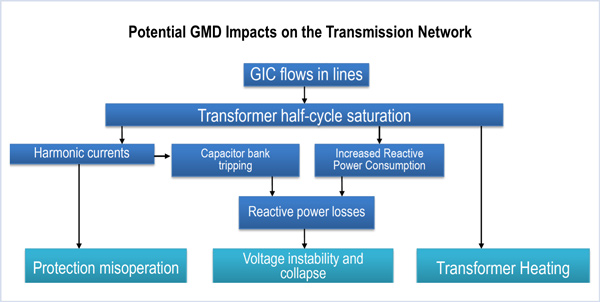PJM last week laid out a timeline for compliance with the geomagnetic disturbance reliability standard approved by FERC in September. (See FERC Approves GMD Reliability Standard.)
The RTO told the Planning Committee it will be required to perform a network vulnerability analysis, and owners of 200-kV and larger transformers must perform transformer heating analyses. As of Jan. 1, stakeholders will have six months to establish roles and responsibilities. Within 18 months, they’ll have to provide models to accomplish the analyses. FERC has allowed up to five years to complete the remainder of the implementation plan.
“We’re not stuck with a blank sheet of paper here,” PJM’s Frank Koza said. “We did a lot of this work in 2014 with all of your cooperation, so we’re pretty far down the road in terms of understanding what needs to be done. We will need to do more in terms of gathering better data for doing the study again, but we’re on our way.”
Among the changes FERC required for the standard is public disclosure of all geomagnetically induced current detector and magnetometer data. Within the PJM region, 47 such devices are in use.
“The science here is not fully done on GMD, so what’s going to be done here is additional research,” Koza said.
Members OK Revised Relay Subcommittee Charter
Members approved an update to the Relay Subcommittee’s charter, which was last amended in 2012.
More Granularity Requested on Winter Reserve Targets
Stakeholders approved PJM’s installed reserve margin study results and recommendations, but they asked the RTO to be more specific with its weekly reserve targets for winter.
The 27% winter reserve target, which is identical to last year, was produced using an average for the entire winter. But the margin needed to meet the one-day-in-10-years loss-of-load expectation ranged as low as 22% in December and peaked at almost 39% for the first week in January.
Stakeholders asked if PJM would switch from a season-long average to monthly ones.
“That’s something that PJM would like to assess internally,” PJM’s Tom Falin said. “I think it’s going to depend on how confident PJM is that the winter peak will happen in January. It doesn’t always.”
PJM to Retire Manual 35
With staff focused on maintaining PJM’s online glossary, the definitions in Manual 35 haven’t been updated in years, explained Janell Fabiano, senior stakeholder process facilitator. That, combined with definitions available in several other outlets, have led PJM to decide to eliminate the manual.
Though the news didn’t generate substantial discussion, it did engender mild protests from some stakeholders. Ed Tatum of AMP and Jim Benchek of FirstEnergy joked about making “Save Manual 35” T-shirts.
Dominion Retiring Bath County Thermal SPS
A special protection scheme used to minimize N-1 overloads and allow for a higher pond level at a pumped storage facility is no longer needed thanks to a number of regional system upgrades.
Dominion Resources plans to retire the Bath County thermal SPS by Dec. 1, but it says the stability SPS there will remain in place.
– Rory D. Sweeney



